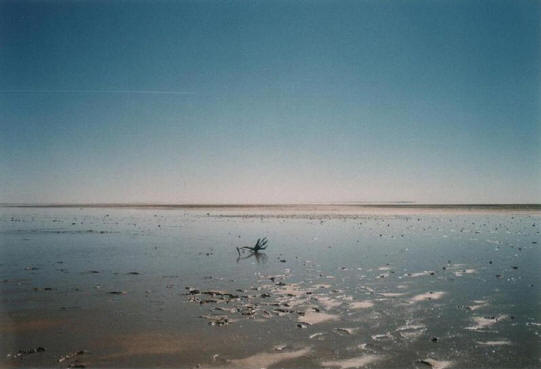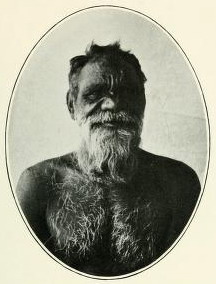|
|
|
 
(Left) View of Lake Eyre from the
South (18 January 2007). © Matt
Malone
(Right) Emil Kintalakadi, a member
of the Tirari nation, east of Lake
Eyre, ±1901.
Bad to the Bones
Aug
30, 2010
Fossils
did not go unnoticed in human
societies that Victorian scholars
once disdainfully labelled ‘brutes’,
‘savages’ and ‘primitives’.
With renewed vigour, today’s
geomythologists explore the ideas
traditional cultures harboured
regarding the nature and the origin
of bones and stones they encountered
on the surface, embedded in rock, or
anywhere else.
The American classicist, Adrienne
Mayor, has documented that the first
nations of the Americas, just like
the Greeks and Romans, recognised
that fossils were the remnants of
creatures that lived in previous
eras and, in many cases, did not die
a natural death.
Intriguingly, pre-modern fossil lore
does not stop there, but often
identifies the extinct life forms
with a mythical race of beings that
dwelled in the sky before its
extermination during a cataclysmic,
lightning-charged battle, or a
world-engulfing fire or deluge.
Though compelling parallels have
been adduced, scholars have not yet
documented the global extent of such
ideas.
One case that has so far eluded
discussion in this context is the
local mythology surrounding the
bones found in the vicinity of Lake
Eyre, in the Tirari Desert of
northern South Australia. The
species represented here are
predominantly those of vertebrate
animals associated with the Tertiary
age.
The Dieri and the Tirari people, who
have traditionally lived on these
grounds, identified these bones as
the relics of a breed of “strange
monsters” known as the Kadimakara
or Kadimerkera. According to
them, these beings once dwelled in a
region in the lower atmosphere that
they described in paradise-like
terms:
'Instead of the present brazen sky,
the heavens were covered by a vault
of clouds, so dense that it appeared
solid; where today the only
vegetation is a thin scrub, there
were once giant gum-trees, which
formed pillars to support the sky;
the air, now laden with blinding,
salt-coated dust, was washed by
soft, cooling rains, and the present
deserts around Lake Eyre were one
continuous garden. The rich soil of
the country, watered by abundant
rain, supported a luxuriant
vegetation, which spread from the
lake-shores and the riverbanks far
out across the plains. The trunks of
lofty gum-trees rose through the
dense undergrowth, and upheld a
canopy of vegetation, that protected
the country beneath from the direct
rays of the sun. In this roof of
vegetation dwelt the strange
monsters known as the "Kadimakara"
or "Kadimerkera"'.
In these words, the comparative
mythologist immediately recognises a
variation on the global motif of a
past golden age, during which a
blessed stock of ancestors lived in
a ‘land’ supported by celestial
pillars. Easy traffic between the
regions above and below is a
signature aspect of the theme: 'Now
and again the scent of the succulent
herbage rose to the roof-land, and
tempted its inhabitants to climb
down the gum-trees to the pastures
below'. However, the denizens of
that hallowed land turned evil and
belligerent, according to a typical
story-line, and inevitably,
catastrophe followed. The Kadimakara
reputedly met their demise some time
after the stanchions of heaven had
subsided:
'Once, while many Kadimakara were
revelling in the rich foods of the
lower world, their retreat was cut
off by the destruction of the three
gum-trees, which were the pillars of
the sky. They were thus obliged to
roam on earth, and wallow in the
marshes of Lake Eyre, till they
died, and to this day their bones
lie where they fell'.
The story concludes with the
collapse of the solid sky, an event
that must also have been thought to
have precipitated the onset of the
dry conditions prevailing in the
area today. At least until the end
of the nineteenth century, the Dieri
continued to make pilgrimages to the
bones and hold corroborees to
'appease the spirits of the dead
Kadimakara, and persuade them to
intercede with those who still dwell
in the sky, and control the clouds
and rain'.
The British geologist and explorer,
John Walter Gregory (1864-1932), who
recorded this tradition during an
expedition in 1901 or 1902, posed
the dilemma presented by this
account:
'It may have arisen as a pure
fiction, invented by some
imaginative, storytelling native, to
explain why large bones are
scattered over the bed of Cooper’s
Creek. It may, on the other hand, be
a shadowy reminiscence of the
geographical conditions which
existed in some distant ancestral
home of the aborigines, or of those
which prevailed in Central
Australia, at some remote period'.
A little more reflection
disqualifies the former option, as
the Dieri would hardly have founded
elaborate rituals and a collective
belief on the fantasy of an
individual. Comparison of the Dieri
story with a similar tradition from
the Arrernte people, farther to the
north, suggested to Gregory that the
myth was based on a core narrative
involving the 'idea of a
sky-country, to which communication
was formerly possible by climbing up
a tree or pole'. This elementary
backbone of the story aligns itself
with the mythology of a sky-reaching
column mythologists refer to as the
axis mundi or ‘world axis’.
Gregory further concluded that the
Dieri 'have modified the story to
explain the occurrence of the great
bones in the rivers of their
country'. He made no bones of his
finding that a systematic pattern
pervades fossil lore: 'As a general
rule, where stories of giants and
dragons are assigned to precise
localities, they are founded on the
occurrence of fossil bones'.
This rule of thumb finds a much
wider, cross-cultural application.
As the outlines of the story seem to
represent a global archetype, it
stands to reason that events in the
cosmic environment surrounding the
earth spawned the myths. The
million-dollar question is whether
the tendency to link local fossils
with this mythical prototype was an
imaginary or whimsical appendix to
the myth or whether the actual
deposition of the fossils was
entwined with environmental
disasters accurately recalled by
these people.
The answer may very well prove to be
the former. However, it may not be
coincidental that Pleistocenic
vertebrates – such as the so-called
‘megafauna’ – are often among the
fossils that attract myths of cosmic
disaster. Besides some mundane
animals such as dingoes, bats,
crocodiles, rodents, and birds, the
specimens collected by Gregory’s
team also included a Diprotodon sp.
or giant wombat, which Emil
Kintalakadi, one of the last
surviving Tirari tribesmen, readily
identified as a Kadimakara.
Surveying the tribal lore, Gregory
noted that the creatures identified
as Kadimakara appear to involve 'two
distinct animals', one a water
monster possibly related to the
fossil remains of crocodiles in the
rivers of Lake Eyre, the other a
unicorn-type beast, 'a big, heavy
land animal, with a single horn on
its forehead'. A striking parallel
emerges with several North American
cultures, who likewise associated
local fossils with two groups of
mythical entities, water monsters
and their supposed rivals, the
thunderbirds.
Gregory advanced the perfectly
reasonable proposition that Dieri
people may have recognised the
perished breed of celestial monsters
in Diprotodon fossils they
sighted in their lands. Does this
preclude any direct relationship
between the fossils and the myth of
legendary sky travellers? Perhaps
not, though one must tread very
carefully.
Interdisciplinary studies involving
plasma physics and archaeoastronomy
suggest that much in the global
myths concerning the end of a
‘golden age’ can be explained on the
hypothesis of a solar storm of
unprecedented proportions, provoking
intense geomagnetic disturbances and
near-lethal synchrotron radiation
emitted by magnetospheric plasma,
possibly in combination with a
cometary interloper. These events
are conjectured to have occurred
between the end of the Pleistocene –
when a comet is also thought to have
impacted or exploded over North
America, according to Firestone and
West – and the end of the Neolithic
period.
If myths like the Kadimakara
tradition preserved a memory of this
tumultuous period, the presence of
megafauna among the purported fossil
remnants at Lake Eyre as well as in
North America, where mammoths and
mastodons exemplify the case, makes
sense.
Could it be that the Dieri, like
other pre-modern societies, had a
sense of the type of mammals that
perished during what was arguably
the latest great extinction event in
geological history? Indeed, is it
conceivable that the Dieri did not
take this myth with them from an
ancestral homeland, as Gregory
tentatively suggested, but were
already stationed on the Australian
continent at the time of these
events, witnessing the eradication
and fossilisation of the unfortunate
animals – including, possibly,
humans – first hand?
Although rock-solid evidence for
this suggestion cannot be marshalled
at this time, no stone should be
left unturned in the giant jigsaw
puzzle that is the planet’s ‘recent’
past.
Contributed by Rens Van Der Sluijs
http://mythopedia.info
Books by Rens Van Der Sluijs:
The Mythology of the World Axis
The World Axis as an Atmospheric
Phenomenon
|
|
|
|
|
|
|
|
|
YouTube video, first glimpses of Episode Two in the "Symbols of an Alien Sky"
series.
|
|
|
|
|
|
|
Three ebooks in the Universe Electric series are
now available. Consistently
praised for easily understandable text and exquisite graphics.
|
|
|
|
|
|
|
|
|
|








